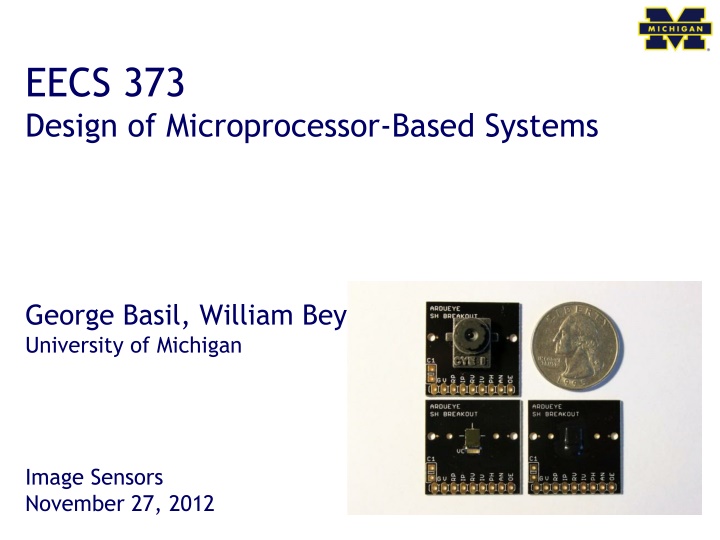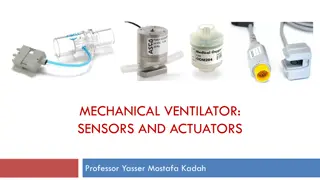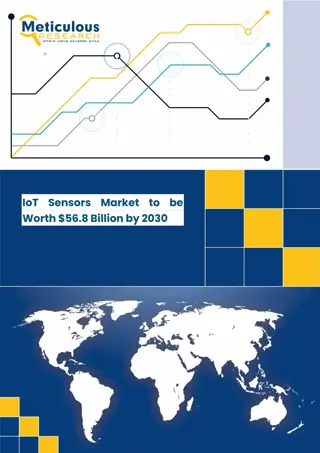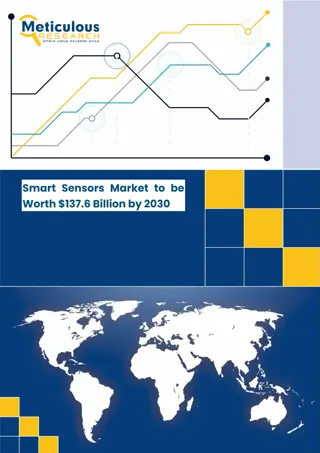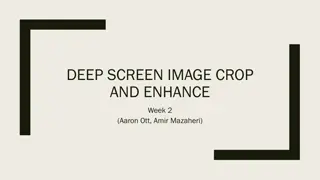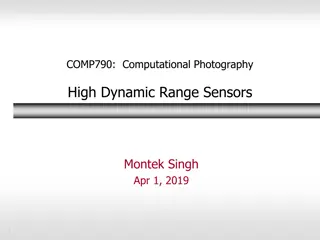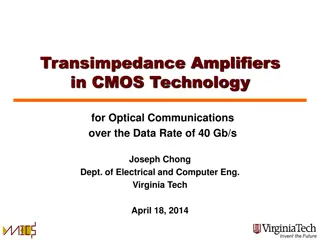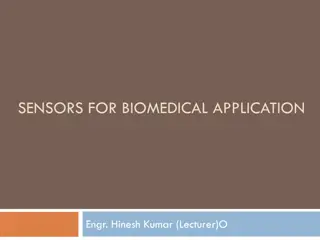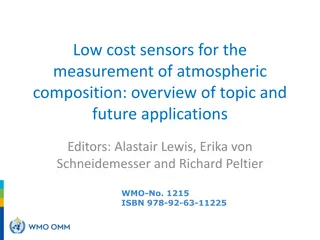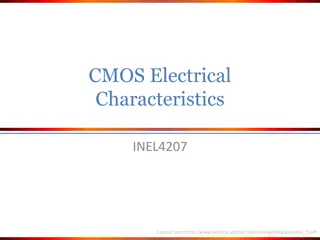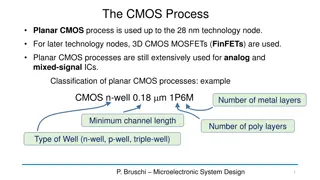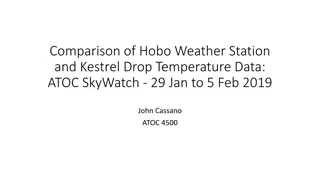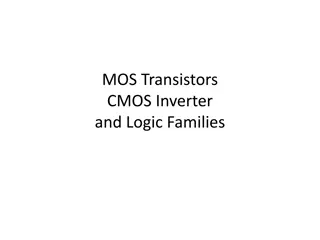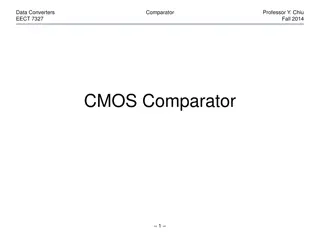Image Sensors: How They Work and Comparison of CCD vs CMOS
Image sensors convert optical images into electronic signals using CCD or CMOS technology. CCD uses electrical charges in each photo sensor, while CMOS converts light energy to voltage. The comparison between CCD and CMOS reveals differences in technology maturity, cost, power usage, and image capture methods like global versus rolling shutters. Vertical smear, skew, and wobble are common issues with these sensor types, impacting image quality in various applications such as consumer cameras, medical imaging, and security systems.
Download Presentation

Please find below an Image/Link to download the presentation.
The content on the website is provided AS IS for your information and personal use only. It may not be sold, licensed, or shared on other websites without obtaining consent from the author.If you encounter any issues during the download, it is possible that the publisher has removed the file from their server.
You are allowed to download the files provided on this website for personal or commercial use, subject to the condition that they are used lawfully. All files are the property of their respective owners.
The content on the website is provided AS IS for your information and personal use only. It may not be sold, licensed, or shared on other websites without obtaining consent from the author.
E N D
Presentation Transcript
EECS 373 Design of Microprocessor-Based Systems George Basil, William Beyer, Joshua Cronk University of Michigan Image Sensors November 27, 2012
What are Image Sensors? Device that converts optical images into an electronic signal o Performance varies widely based on application o Come in many different sizes, pixel densities, etc.. Example Applications o Consumer cameras o Medical imaging o Security (Hausken, 2004, [1])
How do image sensors work? Image sensors typically use CCD or CMOS technology CCD: Charge-coupled device o Light strikes chip and is held as a small electrical charge in each photo sensor o Charges then converted to voltages o Voltages sampled, converted to digital values, and stored for use CMOS: Complementary metal-oxide-semiconductor o Array of pixel sensors made up of photodetectors and amplifiers o Converts light energy to a voltage then to digital data
Comparison of CCD and CMOS CCD was once the dominant type, CMOS making leaps and becoming viable CCD o More mature technology o Uses global shutter to capture image o Susceptible to vertical smear from bright light (overloads sensitivity of a sensor) CMOS o Can use fewer components, less power, provide faster readouts over CCD o Less expensive to manufacture o Uses rolling shutter to capture image o Susceptible to skew, wobble, partial exposure
Comparison of CCD and CMOS - Vertical Smear Vertical smear can be seen via the greenish lines at the bottom of the CCD frame. (Green, n.d. [2])
Comparison of CCD and CMOS - Skew Skew can be seen on the goal posts of the soccer nets above. As the camera is moved during a picture, the goal posts appear to be leaning in a particular direction. (Green, n.d. [2])
Comparison of CCD and CMOS - Wobble Wobble can be seen in the video above. The CMOS image sensor is moved back and forth quickly and results in a distortion of the captured image. (Youtube, 2008 [3])
Comparison of CCD and CMOS - Partial Exposure Partial exposure can be seen in the images above. The rolling shutter captures different areas of a picture under different lighting conditions when a flash is used. (Green, n.d. [2])
Image Sensor Attributes Aspect ratio: ratio of width and height of an image taken by the sensor Pixel count: number of light intensity recording pixels on a sensor o Higher value indicates a higher quality image o Depends on pixel density of viewing screen however Frame rate: rate at which the sensor is able to capture and store a new image
Image Sensor Attributes (Hausken, 2004 [1])
Image Sensor Attributes Power consumption: rate at which the image sensor consumes power o Typically measured in mW o Can vary based on frame rate used Chroma: color spectrum of the image sensor o Mono: grayscale or some other single tone o RGB: mixes red, green, and blue lights to create other colors
Image Sensor Attributes Dynamic range: ratio between largest and smallest capturable quantity of light o A larger dynamic range means the camera can be used in a variety of lighting situations Signal-to-Noise ratio: compares level of desired signal to level of background noise o Ratio of signal power to noise power o Higher ratio means more signal than noise Responsivity: measure of luminous exposure, the amount of light applied to the lens during a given exposure time
Application: Consumer Cameras Desired attributes for consumer cameras o High resolution for quality photos o Or low resolution for power saving o Varying resolutions for video capture o Low power consumption for use in mobile applications Potential cameras Camera Pixels Frames / Sec Power Size 5 MP 15 - 60 fps < 366 mW 10mm x 10mm Aptina MT9P006 4.5 MP 7 - 30 fps < 200 mW 14mm x 14mm Foveon X3 4.5 10.2 MP 4.4 - 30 fps < 50 mW 36mm x 28mm Foveon X3 10.2 0.012 MP ASYNC 1.8 mW - 4mW 2.8mm x 2.8mm Centeye Stonyman
Application: Medical Imaging Desirable Attributes for Medical Imaging o High Resolution for detailed images o Size for specific procedures o High speed o High Sensitivity Potential cameras Camera Pixels Frames / Sec Size 60 MP 1.4 fps 53.7mm x 40.2mm Teledyne FTF9168M 48 MP 1.6 fps 36mm x 48mm Teledyne FTF6080M 1 MP 100 fps 5.73mm x 5.73mm Teledyne FT50M 65 kP 2 - 18 fps 11mm x 26mm(Pill) Given Imaging PillCam
Application: Surveillance Desired attributes for surveillance cameras o Low power requirements o Excellent low-light sensitivity o High resolution to capture minute details Potential cameras Camera Pixels Frames / Sec Power Size 5 MP 15 fps < 381 mW 12mm x 12mm Aptina MT9P031 ~2 MP 15 - 30 fps < 223 - 348 mW 12mm x 12mm Aptina MT9D131
Summary Image sensors can be used for a wide variety of applications Large variety of image sensors on the market o 20+ major companies, each make a variety of sensors o Many different attributes to consider for any given application Technology is constantly evolving o CMOS becoming comparable with CCD sensors A user must weigh the important attributes for the application when deciding the best camera to use
Bibliography 1. Hausken, Tom. (2004). The Image Sensor Market [Powerpoint Slides]. Retrieved from https://docs.google.com/viewer?a=v&q=cache: ecPaPDY2Eb8J:asia.stanford.edu/events/Spring04/slides/hauskenSlides.pdf+ &hl=en&gl=us&pid=bl&srcid=ADGEESjViOQy_0YJACKEg822NWVnNbNFI05Y5K4 Djgv- 2. Green, B. (n.d.). CMOS Rolling Shutter.DVXuser.com :: The online Community for digital filmmaking. Retrieved November 26, 2012, from http://dvxuser.com/jason/CMOS-CCD/ 3. Nikon D90 wobble test - YouTube. (2008, September 30).YouTube. Retrieved November 26, 2012, from http://www.youtube.com/watch?v=KcycneFY9lw
Thank You Any Questions?
